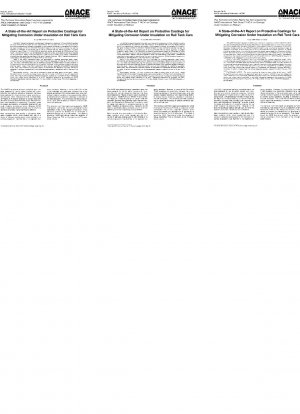NACE 14C296-1996
A State-of-the-Art Report on Protective Coatings for Mitigating Corrosion Under Insulation on Rail Tank Cars (Item No. 24191)
- Standard No.
- NACE 14C296-1996
- Release Date
- 1996
- Published By
- National Association of Corrosion Engineers (NACE)
- Scope
- Corrosion of stainless steel, carbon steel, and aluminum takes place to varying degrees under thermal insulation in the presence of moisture. Water and/or steam may enter the insulation space through penetration points in the jacket, by capillary action (wicking) through or around the insulating medium, or through damaged steam coils. The presence of moisture can lead to general corrosion, pitting, and/or cracking. Because the exterior surfaces of the tank car shell and the interior surfaces of the jacket are not normally inspected after the original construction, such corrosion may go undetected for a great portion of the tank car's expected life unless the jacket is removed. The potential for significant corrosion under insulation on rail tank cars can be related to: ? operating temperature; ? constituents in the insulation that form corrosive solutions when combined with moisture; ? the tendency of some insulation material to absorb and/or retain moisture; ? the insulation's lack of adhesion to the substrate; and ? contact with the commodity being transported. Corrosion was first detected under foam insulation applied to tank cars in the 1960s. Some urethane foams were found to have a propensity to release acids upon exposure to heat and moisture. Consequently, all insulation systems used on tank cars are now subject to corrosion testing in accordance with AAR(1)Specification M-1002, Section 2.2.12.2 This corrosion test is actually designed for foam-in-place (FIP) urethane. In addition to corrosion testing for the insulation system, Section 2.2.12 requires that the exterior surfaces of carbon steel tanks and the interior surfaces of carbon steel jackets be given a protective coating. This state-of-the-art report describes types of insulation and coating systems used on tank cars to provide corrosion control. Temperature limitations are provided for each system. Types of Insulation Materials Following are descriptions of various types of insulation materials that have been used on tank cars. They are listed in descending order based on frequency of use. Fiberglass: A light-density (1.4 to 3.5 lb/ft3 [2.2 to 5.6 kg/m3]) glass fiber with an organic binding resin, a semirigid formed board, or a sheet (sheets are of various densities). Available with various types of factoryattached outer facings. Maximum service temperature has been 450°F (232°C). These materials have very high water absorption, 93% by volume. Ceramic Fiber : A light- to medium-density (2.0 to 8.0 lb/ft3 [3.2 to 12.8 kg/m3]) spun or woven material composed of ceramic fibers. Maximum service temperature has been 3,200°F (1,760°C). These materials have extremely high water absorption and are hygroscopic.
